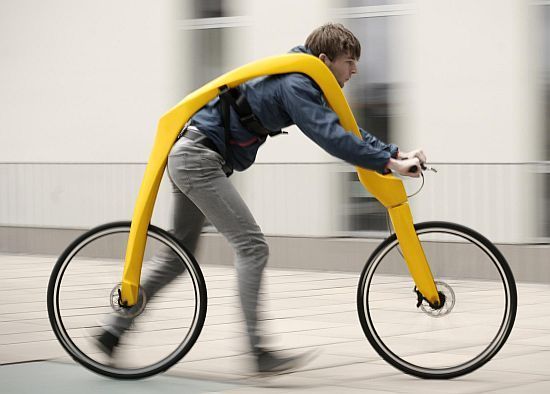Now that I think of it, a solution may be at hand!
A prototype pedal-less bicycle was developed a few years ago. This prototype presents a real opportunity! If we examine the photograph below, we can see that the wheel-size could easily be reduced to 'scooter' wheels, and a little platform created upon which the 'rider' could place her or his feet when moving along. That platform would also provide an attachment point for the electric motor/battery pack necessary to make this an "e-scooter", while still being narrow enough to allow the suspended 'rider' to 'Flintstone' the scooter along using her feet as an auxiliary power source. Alternatively, one could make use of a scooterized version of the Copenhagen wheel.
Thus we see that a narrow 'footprint' is retained, although of necessity we will have a slightly longer 'footprint' than that of current "e-scooters". The next challenge is to provide the rider with the necessary cover, as per the brief defined in the original post. I do not see this as insurmountable. What would be required is vertical extension of the rider-support superstructure, as you see it below, providing it with appropriate 'members' to support a canopy made, of course, of sustainable materials (and see more on this below). That vertical extension is anyway required because the smaller scooter wheel size necessarily lowers the rider; the support harness needs to be raised relative to ground so that the rider can achieve optimum leg extension for efficient auxiliary Flintstoning. The op, @
tandempower, should not be averse to this vertical extension. He is on record here as being a proponent of vertical extension of living space, having suggested elsewhere that we should all of us be willing to live piled on top of one another so as to minimize the spread of habitations horizontally over the land.
Finally, I do not see any reason why the structures necessary for the construction of our covered "e-scooters" cannot be made from sustainable materials -- wood, bamboo, canvas cloth, and so on. The only metals necessary would be those required for bearings and for the electric propulsion system. I can see no downside here. I believe that if such a personal transportation device were designed, produced, and brought to market it would meet with instant and widespread acceptance.
